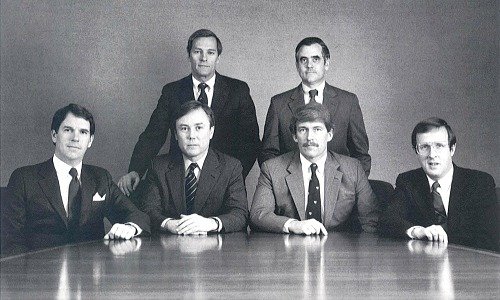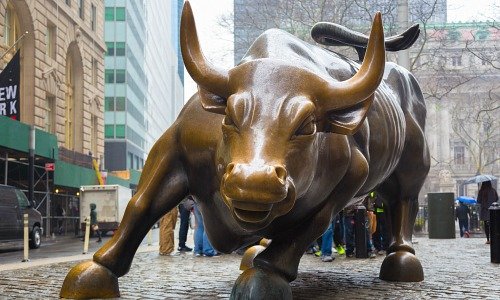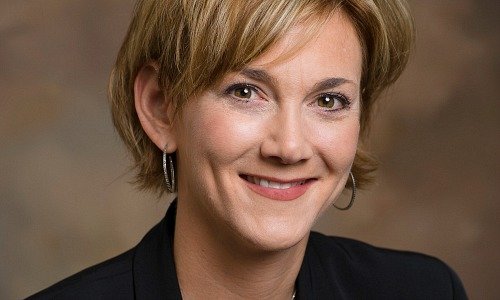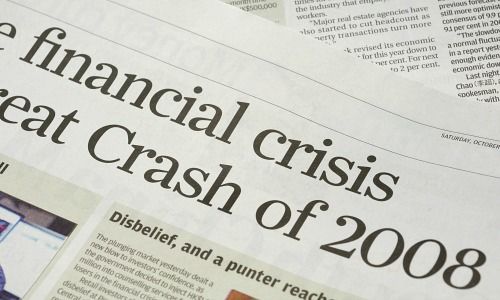T. Rowe Price: Turbulent Asset Management
While the 1970s and 1980s witnessed important changes discussed in part three of this five-piece series, in the next two decades, the financial market experienced turbulence that continues to influence legislation and proceedings today.
Some companies were rocked by the fallout, while for others, it demonstrated the value of prudent risk management and fundamental research.

(The heads of T. Rowe Price in the late 1980s)
The Structure of Asset Management in the 1990s
The 1990s was a good decade for investors. Bonds, equities, as well as private equity and hedge funds, achieved consistent total returns. CAPM (Capital Asset Price Model) and Harry Markowitz’s Modern Portfolio Theory dominated investment strategic thinking and in 1990, Markowitz received the Nobel Prize in Economic Science (even though he developed his theory in 1952).
In terms of trading, the 1990s experienced one of «the greatest» bull markets and in February 1997, the Dow Jones Industrial average was pushed above 7000 points. The industry’s structure, however, remained focused on traditional asset classes with equities and bonds at the forefront and little attention paid to alternatives.

(The 1990s witnessed one of the strongest bull markets in history, Image: Shutterstock)
Asset Management and Digitalization
During the 1990s, technology came to the fore, not only in operations but also for the client experience. Corporations changed their procedures from paper-based to virtual and asset management firms started to build up their online presence as more and more clients gained access to the internet.
In 1996, for example, T. Rowe Price launched its corporate website. Almost at the same time, the firm surpassed $100 billion in AUM.
An Industry Faces Its Downfall
While the 1990s were a decade of excitement, the new millennium brought widespread change to the financial industry as excitement turned to greed. Many firms chased momentum and turned to unethical practices for easy profit. Others, such as T. Rowe Price, rejected this approach to what seemed like their detriment.
In 2000 and 2001, excessive speculation around the internet sphere came to an abrupt halt with the so-called dot-com crash – or the bursting of the New Economy bubble. Despite widespread mockery from investment peers and the media for its contrarian stance, T. Rowe Price had refused to follow what it saw as a dangerously overpriced fad.
Faced With the Worst Recession in 80 Years
This belief was vindicated when the market crashed. The firm’s Science and Technology Equity Strategy shrank from $12 billion to $3.2 billion but this strategy, and many of the firm’s other products were better protected because they had avoided the dot-com hype.
In 2008, Lehmann Brothers, a global bank, collapsed. This event almost brought down the world’s financial system. Economies around the globe were faced with the worst recession in 80 years. It was only because of the massive monetary and fiscal stimulus that the formation of another “Great Depression” as the one in 1929 was prevented.
How Did the Financial Crisis Effect the Asset Management Industry?
The global value of professionally managed assets (AUM) declined by 18 percent during the financial crisis to $48.6 trillion. Investors fled asset classes they considered too risky, illiquid or nontransparent – a major example were hedge funds. Instead, investors focused on asset classes they perceived to be safer, such as ETFs (ETFs were one of the products that benefitted from the financial crisis).
On top of shrinking assets under management, confidence in the asset management industry was hurt badly. Investors were concerned about dubious advice, poor risk management, and even fraud in some cases.
Refused to Follow the Pack
The situation was different for T. Rowe Price. Once again, its investment professionals had refused to follow the pack and the company was ahead of market conditions when the crisis broke. Nevertheless, T. Rowe Price’s AUM was reduced from $400 billion in 2007 to $276.3 billion in 2008 due to battered markets around the world.
Despite its drop in AUM, the company maintained its strong balance sheet and had no liquidity issues. They even hired people during the crisis, while others pulled back.

(Susan Troll foresaw the 2008 financial crisis in 2006)
T. Rowe Price saw a potential crisis brewing as early as 2006, thanks to Susan Troll, a fixed income credit analyst still with the company. Her rigorous research helped the firm to distance itself from the subprime credit market and take measures to reduce exposure to other risks as well. In a 2008 interview with «Kiplinger», Troll stated that she recognized a lot of «red flags» with regards to the subprime market.
Some People Saw it Coming
Her research helped T. Rowe Price distance itself from the subprime credit market when the crisis broke. «The subprime market was so irrational that a huge correction was absolutely necessary,» Troll said. What surprised her, however «was the speed and severity of the downturn.» When asked why others found it so hard to see the risks, Troll explained: «Some people saw it coming. But it’s hard to pull back from a market that’s booming.»
This material is being furnished for general informational purposes only. The material does not constitute or undertake to give advice of any nature, including fiduciary investment advice, and prospective investors are recommended to seek independent legal, financial and tax advice before making any investment decision. T. Rowe Price group of companies including T. Rowe Price Associates, Inc. and/or its affiliates receive revenue from T. Rowe Price investment products and services. Past performance is not a reliable indicator of future performance. The value of an investment and any income from it can go down as well as up. Investors may get back less than the amount invested. The material does not constitute a distribution, an offer, an invitation, a personal or general recommendation or solicitation to sell or buy any securities in any jurisdiction or to conduct any particular investment activity. The material has not been reviewed by any regulatory authority in any jurisdiction.
Information and opinions presented have been obtained or derived from sources believed to be reliable and current; however, we cannot guarantee the sources' accuracy or completeness. There is no guarantee that any forecasts made will come to pass. The views contained herein are as of the date noted on the material and are subject to change without notice; these views may differ from those of other T. Rowe Price group companies and/or associates. Under no circumstances should the material, in whole or in part, be copied or redistributed without consent from T. Rowe Price. The material is not intended for use by persons in jurisdictions which prohibit or restrict the distribution of the material and in certain countries the material is provided upon specific request. It is not intended for distribution to retail investors in any jurisdiction.
Switzerland -Issued in Switzerland by T. Rowe Price (Switzerland) GmbH, Talstrasse 65, 6th Floor, 8001 Zurich, Switzerland. For Qualified Investors only. © 2019 T Rowe Price. All rights reserved. T. ROWE PRICE, INVEST WITH CONFIDENCE and the Bighorn Sheep design are, collectively and/or apart, trademarks or registered trademarks of T. Rowe Price Group, Inc.



























